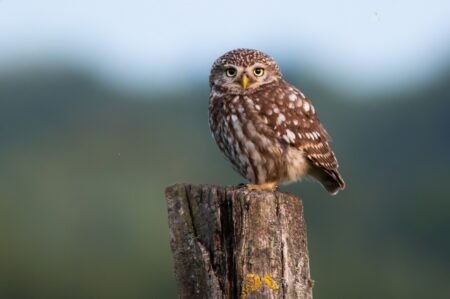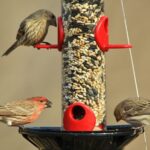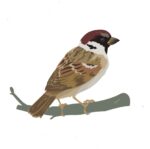Do Owls Eat Birds?
Owls are birds of prey that are known for their large, round heads, sharp talons, and silent flight. They are one of the most fascinating and mysterious bird species in the world, and one common question that people have about them is: Do owls eat birds?
The short answer to this question is yes, owls do eat birds. In fact, birds are one of the most common prey for owls, along with mice, voles, and other small mammals. However, it is important to note that not all owl species eat birds and their diet can vary depending on their size, habitat, and hunting style.
Some owl species, such as the burrowing owl and the snowy owl, primarily feed on small mammals like rodents and rabbits. Others, like the great gray owl and the great horned owl, have a more diverse diet and will hunt for birds, reptiles, amphibians, and even fish.
So why do some owls eat birds while others don’t? One factor is the size and strength of the owl. Larger owls, such as the Eurasian eagle owl, have the ability to hunt and kill larger birds, like seagulls and ducks. Meanwhile, smaller owls may stick to smaller prey such as finches and sparrows.
Another important factor is habitat. Owls that live in or near forests, such as the barred owl, may have a higher chance of hunting birds as their natural habitat is home to many avian species. Owls that live in open areas, such as the barn owl, may have a diet that primarily consists of rodents and insects.
Hunting style also plays a role in an owl’s diet. Some owls, like the snowy owl, are diurnal hunters, meaning they hunt during the day. These owls may have a better chance of catching birds as they are active during the same time as many bird species. Nocturnal owls, on the other hand, may have a higher chance of catching small mammals as they are more active during the night.
Do Owls Eat Birds?
Yes, owls are predators and will eat other birds, including smaller owls. They hunt and eat a variety of prey, including small mammals, insects, fish, and birds. The specific diet of an owl depends on its size and habitat. Larger owls, like great horned owls, may even hunt and eat larger birds, such as ducks or pheasants.
What Types Of Birds Do Owls Eat?
- Owls are apex predators and are generally referred to as birds of prey, meaning they hunt and feed on other animals. Their diet primarily consists of small mammals, insects, fish, and even other birds. However, the types of birds they eat may vary depending on the specific owl species, their habitat, and their range.
- Small birds: Owls are known to feed on various small birds, including sparrows, finches, warblers, and thrushes. They are swift hunters and can silently swoop down from above to catch their prey. These small birds make up a significant portion of an owl’s diet, especially for species living in urban areas.
- Waterfowl: Larger owl species, such as Great Horned Owls and Snowy Owls, have been observed catching and eating waterfowl like ducks and geese. These owls have powerful talons and beaks, making it easier for them to catch and kill larger birds.
- Birds of prey: Although owls are considered to be predatory birds, they also face competition from other birds of prey, such as hawks and falcons. In some cases, owls have been observed preying on smaller birds of prey like kestrels and even other owl species.
- Insects: Some owl species, such as the Eastern Screech Owl and Burrowing Owl, have a considerable portion of their diet consisting of insects. They hunt for insects like grasshoppers, moths, beetles, and spiders, which are abundant in their habitats.
- Reptiles: Owls are opportunistic hunters and may also target reptiles like lizards, snakes, and small turtles. They have been observed preying on these animals in areas where they are abundant.
Overall, owls have a diverse diet and can adapt to different prey depending on their habitat and range. Their hunting abilities and flexibility in diet make them efficient apex predators in their ecosystems.
Do Owls Eat Fruit?
Yes, some species of owls do eat fruit, but it is not a significant part of their diet. Most owls are carnivorous and primarily eat insects, small mammals, and other birds. Some owls, such as the snowy owl, may occasionally eat berries or fruits when their preferred prey is scarce. However, they are not considered fruit-eating animals.
Do Owls Eat Squirrels?
Yes, owls do eat squirrels. Owls are carnivorous birds of prey that primarily feed on small mammals, including rodents like squirrels. Other common food sources for owls include birds, insects, fish, and reptiles. Owls hunt at night and use their keen eyesight and hearing to locate their prey. Some species of owls, such as the great horned owl, are able to take down prey as large as rabbits or even skunks.
Do Owls Eat Small Birds?
Yes, owls do eat small birds. In fact, small birds such as sparrows, finches, and robins make up a significant portion of an owl’s diet. Owls are skilled hunters and have excellent eyesight and hearing, allowing them to locate and capture their prey, including small birds. Some owl species, such as the great horned owl, are known for hunting and consuming other birds, even those larger than themselves. So yes, owls do eat small birds as part of their regular diet. However, it is important to note that not all owls eat small birds exclusively, as their diet can also include insects, rodents, reptiles, and even other small animals.
SEE ALSO: How To Attract Bird To Feeders: Step-by-Step Guide
Do Owls Eat Birds in The Winter?
Yes, owls do eat birds in the winter. In fact, winter may be a more challenging time for owls to find food, so they may rely more heavily on birds as a food source. Owls are opportunistic predators and will hunt and eat whatever prey is available to them, including birds, small mammals, insects, and even other owls. They have excellent hearing and eyesight, which allows them to hunt for prey even in low-light conditions during the winter months. Some species of owls, such as snowy owls, are known to migrate to more southern areas during the winter where prey may be more abundant. However, even in these areas, they will still hunt and eat birds as part of their diet.
Do Owls Eat Frogs?
Yes, owls do eat frogs. Frogs are a common food source for many owl species, as they are small, abundant, and easy to catch. However, not all owl species eat frogs, and some may prefer other prey items such as insects, small mammals, or birds. The type of prey a particular owl species eats depends on its size, habitat, and hunting behavior.
Which Owls Eat Birds?
Not all owls eat birds, but many do. Some of the types of owls that commonly eat birds include the Great horned owl, the Screech owl, and the Barn owl.
- Great horned owl: This large and powerful owl is known to eat a wide variety of prey, including birds. It has been recorded to consume species such as crows, pigeons, hawks, and even other smaller owls. Its sharp talons and strong beak make it a formidable hunter of birds.
- Screech owl: Despite its small size, the Screech owl is known to hunt and eat birds that are larger than itself. It preys on small songbirds, such as sparrows and finches, as well as larger birds like doves and woodpeckers.
- Barn owl: This nocturnal owl has a unique hunting style where it flies low to the ground and uses its excellent hearing to locate prey. It mostly eats small mammals like mice and voles, but it also takes advantage of birds that are roosting or nesting on the ground.
Owls are efficient and skilled hunters, and they have adapted to be able to catch and eat a variety of different prey, including birds. They have powerful talons and sharp beaks that help them catch and kill their prey, making them a significant predator to many bird species. However, it’s worth noting that not all owls eat birds, as some species, like the Burrowing owl, primarily feed on insects.
Why Do Owls Eat Birds?
- Nutritional Needs: Owls are carnivorous birds and need a diet high in protein and fat to maintain their energy levels. Birds provide a concentrated source of these nutrients, making them ideal prey for owls.
- Easy Prey: Birds are often small and active, making them easy targets for owls. Owls have excellent eyesight and can fly silently, allowing them to sneak up on their prey undetected.
- Abundance of Birds: Birds are one of the most abundant prey species available to owls. They can be found in various habitats and in large numbers, making them a convenient and reliable food source for owls.
- Adaptations: Owls have evolved to be highly adapted for hunting birds. They have sharp talons and strong beaks, allowing them to easily catch and kill their avian prey.
- Variety of Species: There is a wide variety of bird species that owls can prey on, from small songbirds to larger game birds like pheasants. This provides owls with a diverse and consistent food source.
- Camouflage: Many owl species have excellent camouflage that allows them to blend into their surroundings. This makes it easier for owls to stalk and capture birds without being seen.
- Territorial Competition: Some owls, such as the great horned owl, are apex predators and will compete with other carnivorous birds for food. Eating birds gives them a competitive advantage as they are able to target prey that other birds may not be able to catch.
- Prey Availability: Owls are primarily nocturnal hunters, and many birds are also most active during the night. This increases the likelihood of owls encountering and hunting birds for food.
- Efficient Hunting: Owls have specialized feathers that allow them to fly silently and hear the slightest movements of their prey. This makes them highly efficient hunters, giving them a better chance of catching birds compared to other predators.
- Instinctual Behavior: Eating birds is a natural and instinctual behavior for owls. They have been hunting and preying on birds for millions of years and continue to do so as part of their natural predatory behavior.
How Do Owls Hunt Other Birds?
Owls are adept hunters, with specially adapted physical features and hunting strategies that allow them to capture and consume a variety of prey, including other birds.
One of the main ways in which owls hunt other birds is by utilizing their excellent vision and incredible hearing. Owls have large, forward-facing eyes that give them exceptional depth perception and allow them to see their prey in low-light conditions. They also have incredibly sensitive hearing, with asymmetrical ears that allow them to pinpoint the exact location of their prey based on sound alone.
Once an owl has spotted a potential prey bird, it will silently fly toward it, using its specialized feathers to muffle the sound of its wings. This stealthy approach allows the owl to get as close as possible to its target before attacking.
The most common hunting strategy employed by owls when targeting other birds is the swoop-and-grab method. In this technique, the owl will fly quickly and silently towards the prey, and at the last moment, extend its sharp talons to capture it. The owl’s strong legs and sharp talons are designed to grasp and hold onto the prey, making it difficult for the bird to escape.
In addition to using their physical abilities, owls also employ some clever hunting tactics to catch other birds. Some species of owls, such as the snowy owl, will use their white feathers to blend into their wintry surroundings, making it easier for them to surprise and catch their prey. Other owls, such as the eagle owl, will perch on high branches or rocks to scan for prey from a distance before swooping in to catch it.
Another hunting technique that owls use is called “still-hunting.” In this strategy, the owl sits very still and patiently waits for its prey to come within striking distance. This is most commonly used by larger owl species, such as the great horned owl, and is particularly effective when targeting small, unsuspecting birds.
Many owls also have powerful and sharp beaks, which they use to tear apart their prey. After capturing a bird, the owl will use its beak to break the neck or spine of its catch before consuming it.
Overall, owls are masterful hunters, and their hunting abilities and strategies make them formidable predators of other birds.
SEE ALSO: Do Mosquitoes Bite Dogs? Here Is What You Need To Know
FAQs
Q. What animals do owls eat most?
A. Owls are known to be opportunistic predators and their diet varies depending on their size and habitat. However, their primary source of food is small mammals such as rodents, including mice, voles, shrews, and rats. They also eat insects, fish, birds, reptiles, and amphibians. Some larger species of owls, such as the horned owl and snowy owl, can also prey on larger mammals like rabbits or squirrels.
Q. Do owls eat cats?
A. Some species of owls, such as the Eurasian eagle owl, have been known to prey on small domestic cats.
Q. Is Owl a friendly bird?
A. Owls can be friendly toward humans if they have been socialized and trained properly.
Q. Do owls eat birds during the day?
A. Generally, no, owls do not eat birds during the day.
Q. Do owls eat birds at night?
A. Yes, owls are nocturnal birds of prey that primarily hunt and eat other birds during the night.
Conclusion
Owls primarily eat small mammals, insects, and other small prey. While they may occasionally eat birds, they do not rely on them as a main source of food. Other factors, such as habitat and proximity to human activity, may influence their diet and hunting habits. Overall, while owls may eat birds, they are not considered a significant part of their diet.


